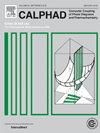Extension of the modified quasichemical model in the distinguishable-pair approximation to multicomponent solutions via an on-the-fly interpolation framework
IF 1.9
3区 材料科学
Q4 CHEMISTRY, PHYSICAL
Calphad-computer Coupling of Phase Diagrams and Thermochemistry
Pub Date : 2025-07-04
DOI:10.1016/j.calphad.2025.102852
引用次数: 0
Abstract
The Modified Quasichemical Model in the Distinguishable-Pair Approximation (MQMDPA) was originally developed to describe thermodynamic properties of binary solutions with manifold short-range ordering (SRO) among atoms. This study extends the MQMDPA to multicomponent solutions through the development of an on-the-fly bond-energy formalism (OTFBEF). The OTFBEF employs interpolation functions to dynamically transform bond energy expressions from binary to ternary and higher-order multicomponent systems. By fixing the interpolation functions to specific values, the OTFBEF seamlessly reduces to traditional geometric methods, the generic method, or the hybrid Kohler-Toop loop framework, ensuring compatibility with established approaches, particularly with the widely used MQMPA. The interpolation functions can be optimized using experimental data from ternary systems or theoretically defined through integral and partial methods, providing flexibility for both prediction and calibration. The versatility and generality of the OTFBEF empower the MQMDPA to model multicomponent solutions with complex configurations effectively. Future work will focus on expanding the MQMDPA within a two-sublattice framework to address reciprocal solutions, further enhancing its applicability.
利用动态插值框架将可分辨对近似中修正的准化学模型推广到多组分解
可分辨对近似中的修正准化学模型(MQMDPA)最初是为了描述原子间具有流形短程有序(SRO)的二元解的热力学性质而建立的。本研究通过开发动态键能形式(OTFBEF)将MQMDPA扩展到多组件解决方案。OTFBEF采用插值函数将键能表达式从二元系统动态转换为三元高阶多组分系统。通过将插值函数固定到特定值,OTFBEF可以无缝地简化为传统的几何方法、通用方法或混合Kohler-Toop循环框架,从而确保与现有方法的兼容性,特别是与广泛使用的MQMPA的兼容性。插值函数可以利用三元系统的实验数据进行优化,也可以通过积分和部分方法进行理论定义,为预测和校准提供了灵活性。OTFBEF的多功能性和通用性使MQMDPA能够有效地为具有复杂配置的多组件解决方案建模。未来的工作将侧重于在两个子格框架内扩展MQMDPA,以解决相互解决方案,进一步增强其适用性。
本文章由计算机程序翻译,如有差异,请以英文原文为准。
求助全文
约1分钟内获得全文
求助全文
来源期刊
CiteScore
4.00
自引率
16.70%
发文量
94
审稿时长
2.5 months
期刊介绍:
The design of industrial processes requires reliable thermodynamic data. CALPHAD (Computer Coupling of Phase Diagrams and Thermochemistry) aims to promote computational thermodynamics through development of models to represent thermodynamic properties for various phases which permit prediction of properties of multicomponent systems from those of binary and ternary subsystems, critical assessment of data and their incorporation into self-consistent databases, development of software to optimize and derive thermodynamic parameters and the development and use of databanks for calculations to improve understanding of various industrial and technological processes. This work is disseminated through the CALPHAD journal and its annual conference.

 求助内容:
求助内容: 应助结果提醒方式:
应助结果提醒方式:


